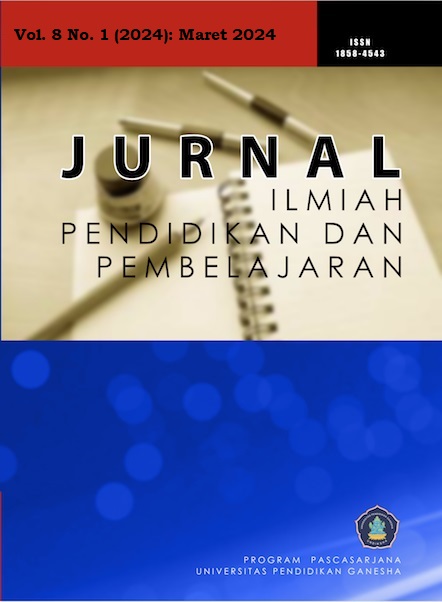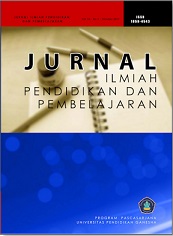Website-Based Learning Media Using Weebly Water Cycle Material for Elementary School Teachers
DOI:
https://doi.org/10.23887/jipp.v8i1.63237Keywords:
Learning Media, Website, Elementary School TeachersAbstract
21st-century learning activities: Students quickly get bored with monotonous learning. The learning media used is still traditional, so it needs to keep up with the times. This research analyzes website-based learning media for elementary school teachers using Weebly water cycle material. The type of research used is survey research with quantitative research methods. The subjects in this research were 100 elementary school teachers. The data collection technique used in this research is a questionnaire. The data analysis technique used is structural equation modeling-partial least square (SEM-PLS) with software using the SmartPLS 4.0 application. The research results show that Facilitating Conditions (FC) positively and significantly influence Behavior Intention (BI) in elementary school teachers' use of website-based learning media. Hedonic motivation (HM) positively and considerably influences elementary school teachers' behavior intention (BI) using website-based learning media. Social Influence (SI) positively and considerably influences behavior Intention (BI) in using website-based learning media for elementary school teachers. The research concludes that website-based learning media, using Weebly, positively influences elementary school teachers. This research implies that website learning media can adapt to different student learning styles because various media types are appropriate for student needs.
References
Adedoyin, O. B., & Soykan, E. (2023). Covid-19 pandemic and online learning: the challenges and opportunities. Interactive Learning Environments, 31(2), 863–875. https://doi.org/10.1080/10494820.2020.1813180.
Adzkiya, D. S., & Suryaman, M. (2021). Penggunaan Media Pembelajaran Google Site dalam Pembelajaran Bahasa Inggris Kelas V SD. Educate: Jurnal Teknologi Pendidikan, 6(2), 20–31. https://doi.org/10.32832/educate.v6i2.4891.
Afnan, M., Lasmawan, I. W., & Margunayasa, I. G. (2022). Media Pembelajaran IPS Berbasis Android pada Topik Globalisasi di Sekitarku Bermuatan Tri Hita Karana untuk Siswa Kelas VI Sekolah Dasar. MIMBAR PGSD Undiksha, 10(1), 1–8. https://doi.org/10.23887/jjpgsd.v10i1.44487.
Al-Azawei, A., & Alowayr, A. (2020). Predicting the intention to use and hedonic motivation for mobile learning: A comparative study in two Middle Eastern countries. Technology in Society, 62, 101325. https://doi.org/10.1016/j.techsoc.2020.101325.
Allahawiah, S., Altarawneh, H., & Almajaly, N. (2023). The Impact of Virtual Classrooms and Google Sites on Teaching Computer Skills Courses: Karak University College-Jordan. International Journal of Emerging Technologies in Learning, 18(7). https://doi.org/10.3991/ijet.v18i07.36591.
Anindita, R., Pramitaningrum, I. K., & Kusumawati, A. (2022). Identifikasi Telur Parasit Helminth Berbasis Aplikasi Android untuk Pembelajaran Praktikum Daring di Era Pandemi Covid-19. Journal Of Health, 9(1), 24 – 30. https://doi.org/10.30590/joh.v9n1.389.
Argo, J. J., & Dahl, D. W. (2020). Social influence in the retail context: a contemporary review of the literature. Journal of Retailing, 96(1), 25–39. https://doi.org/10.1016/j.jretai.2019.12.005.
Balkaya, S., & Akkucuk, U. (2021). Adoption and use of learning management systems in education: The role of playfulness and self-management. Sustainability (Switzerland), 13(3), 1–27. https://doi.org/10.3390/su13031127.
Bashori, M., van Hout, R., Strik, H., & Cucchiarini, C. (2021). Effects of ASR-based websites on EFL learners’ vocabulary, speaking anxiety, and language enjoyment. System, 99(July 2021), 102496.1-16. https://doi.org/10.1016/j.system.2021.102496.
Chiou, W. C., Lin, C. C., & Perng, C. (2010). A strategic framework for website evaluation based on a review of the literature from 1995–2006. Information & Management, 47(5–6), 282–290. https://doi.org/10.1016/j.im.2010.06.002.
Ciranka, S., & van den Bos, W. (2021). Adolescent risk-taking in the context of exploration and social influence. Developmental Review, 61, 100979. https://doi.org/10.1016/j.dr.2021.100979.
Dharma, P. K. D., & Agung, A. A. G. (2021). Pengembangan Multimedia Online pada Muatan Pelajaran IPA. Jurnal Ilmiah Pendidikan Dan Pembelajaran, 5(1), 115–123. https://doi.org/10.23887/JIPP.V5I1.32164.
Fitriyani, W., & Solihati, N. (2022). The Effect of Powtoon-Based Audiovisual Media on Indonesian Language Learning Outcomes. Mimbar PGSD Undiksha, 10(1), 148–154. https://doi.org/10.23887/jjpgsd.v10i1.46996.
Indarta, Y., Jalinus, N., Waskito, W., Samala, A. D., Riyanda, A. R., & Adi, N. H. (2022). Relevansi Kurikulum Merdeka Belajar dengan Model Pembelajaran Abad 21 dalam Perkembangan Era Society 5.0. Edukatif: Jurnal Ilmu Pendidikan, 4(2), 3011–3024. https://doi.org/10.31004/edukatif.v4i2.2589.
Kim, J., & Lee, K. S. (2020). Conceptual model to predict Filipino teachers ’ adoption of ICT-based instruction in class : using the UTAUT model. Asia Pacific Journal of Education, 00(00), 1–15. https://doi.org/10.1080/02188791.2020.1776213.
Nalasari, K. A., Suarni, N. K., & Wibawa, I. M. C. (2021). Pengembangan bahan ajar berbasis web google sites pada tema 9 subtema pemanfaatan kekayaan alam di Indonesia untuk siswa kelas IV sekolah dasar. Jurnal Teknologi Pembelajaran Indonesia, 11(2), 135–146. https://doi.org/10.23887/jurnal_tp.v11i2.658.
Nikolopoulou, K., Gialamas, V., & Lavidas, K. (2021). Habit, hedonic motivation, performance expectancy and technological pedagogical knowledge affect teachers’ intention to use mobile internet. Computers and Education Open, 2, 100041. https://doi.org/10.1016/j.caeo.2021.100041.
Ningtyas, D. N., & Sihombing, A. A. (2023). Blended Learning : Pembelajaran Abad 21 Sebagai ‘ Jalan - Tengah ’ Menjaga Kualitas Pendidikan Di Era Pandemi Covid-19. Edukasi: Jurnal Penelitian Pendidikan Agama Dan Keagamaan, 21(1), 59–75. https://doi.org/10.32729/edukasi.v21i1.1420.
Nugroho, M. K. C., & Hendrastomo, G. (2021). Pengembangan Media Pembelajaran Berbasis Google Sites Pada Mata Pelajasan Sosiologi Kelas X. Jurnal Pendidikan Sosiologi Dan Humaniora, 12(2), 59–70. https://doi.org/10.26418/j-psh.v12i2.48934.
Nurrita, T. (2018). Pengembangan Media Pembelajaran Untuk Meningkatkan Hasil Belajar Siswa. MISYKAT: Jurnal Ilmu-Ilmu Il-Quran, Hadist, Syari’ah Dan Tarbiyah, 3(1), 171. https://doi.org/10.33511/misykat.v3n1.171.
Nurrohma, R. I., & Adistana, G. A. Y. P. (2021). Penerapan Model Pembelajaran Problem Based Learning dengan Media E-Learning Melalui Aplikasi Edmodo pada Mekanika Teknik. Edukatif: Jurnal Ilmu Pendidikan, 3(4), 1199–1209. https://doi.org/10.31004/edukatif.v3i4.544.
Safi, A., & Singh, S. (2023). A systematic literature review on phishing website detection techniques. Journal of King Saud University-Computer and Information Sciences, 35(2), 590–611. https://doi.org/10.1016/j.jksuci.2023.01.004.
Salsabila, F., & Aslam, A. (2022). Pengembangan media pembelajaran berbasis web google sites pada pembelajaran IPA Sekolah Dasar. Jurnal Basicedu, 6(4), 6088–6096. https://doi.org/10.31004/basicedu.v6i4.3155.
Shukla, S. (2021). M-learning adoption of management students’: A case of India. In Education and Information Technologies (Vol. 26, Issue 1). Education and Information Technologies. https://doi.org/10.1007/s10639-020-10271-8.
Silalahi, M. V. (2020). Development of E-Modules Based on Exe-Learning on Topics of Reaction Rate Against Student Learning Outcomes Mechanical Engineering. IJECA (International Journal of Education and Curriculum Application), 3(2), 114–120. https://doi.org/10.31764/ijeca.v3i2.2672.
Siregar, Z., & Marpaung, T. B. (2020). Pemanfaatan Teknologi Informasi dan Komunikasi (TIK) Dalam Pembelajaran di Sekolah. BEST Journal (Biology Education, Sains and Technology), 3(1), 61–69. https://doi.org/10.30743/best.v3i1.2437.
Stewart, O. G. (2023). Using digital media in the classroom as writing platforms for multimodal authoring, publishing, and reflecting. Computers and Composition, 67, 102764. https://doi.org/10.1016/j.compcom.2023.102764.
Stewart, O. G. (2024). Analyzing High School Students’ Mulitmodal Compositions with Digital Media Platforms Using Metafunctions. LANGUAGE AND LITERACY: A CANADIAN EDUCATIONAL E-JOURNAL, 26(1). https://doi.org/10.20360/langandlit29608.
Tika, I. N., & Agustiana, I. G. A. T. (2021). The Effect of a Blended Learning Project Based Learning Model on Scientific Attitudes and Science Learning Outcomes. Jurnal Ilmiah Sekolah Dasar, 5(4), 557–566. https://doi.org/10.23887/jisd.v5i4.39869.
Widayanti, W., & Yuberti, Y. (2018). Pengembangan alat praktikum sederhana sebagai media praktikum mahasiswa. JIPFRI (Jurnal Inovasi Pendidikan Fisika Dan Riset Ilmiah), 2(1), 21–27. https://doi.org/10.30599/jipfri.v2i1.161.
Wu, Z., He, T., Mao, C., & Huang, C. (2020). Exam paper generation based on performance prediction of student group. Information Sciences, 532(September 2020), 72–90. https://doi.org/10.1016/j.ins.2020.04.043.
Yusandika, A. D., Istihana, I., & Susilawati, E. (2018). Pengembangan media poster sebagai suplemen pembelajaran fisika materi tata surya. Indonesian Journal of Science and Mathematics Education, 1(3), 187–196. https://doi.org/10.24042/ijsme.v1i3.3593.
Downloads
Published
How to Cite
Issue
Section
License
Copyright (c) 2023 Lebyana Norma Belinda

This work is licensed under a Creative Commons Attribution-ShareAlike 4.0 International License.
Authors who publish with the Jurnal Ilmiah Pendidikan dan Pembelajaran (JIPP) agree to the following terms:
- Authors retain copyright and grant the journal the right of first publication with the work simultaneously licensed under a Creative Commons Attribution License (CC BY-SA 4.0) that allows others to share the work with an acknowledgment of the work's authorship and initial publication in this journal.
- Authors are able to enter into separate, additional contractual arrangements for the non-exclusive distribution of the journal's published version of the work (e.g., post it to an institutional repository or publish it in a book), with an acknowledgment of its initial publication in this journal.
- Authors are permitted and encouraged to post their work online (e.g., in institutional repositories or on their website) prior to and during the submission process, as it can lead to productive exchanges, as well as earlier and greater citation of published work. (See The Effect of Open Access)










